by Henry P. Olsen
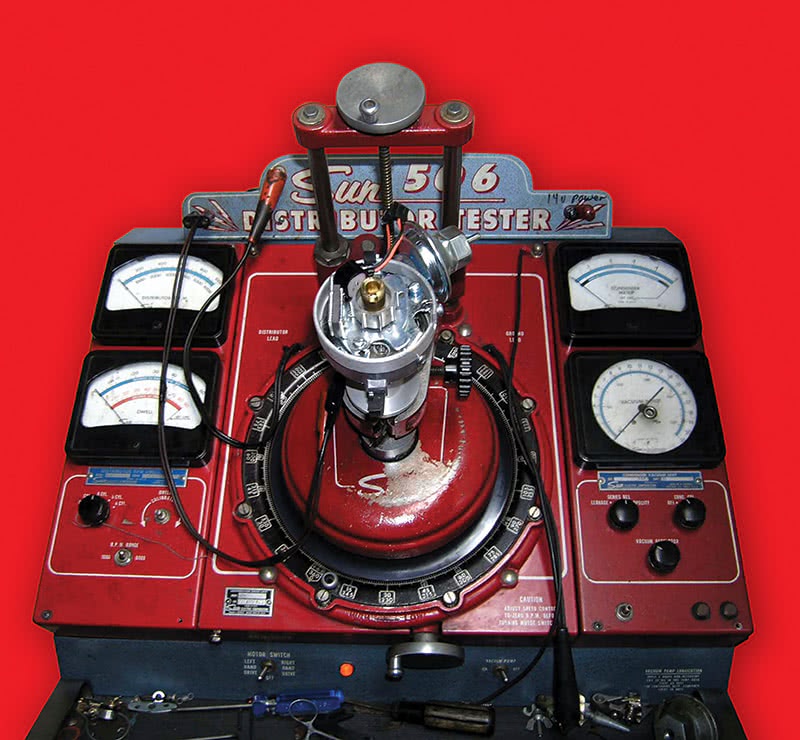
A distributor machine may be profoundly obsolete in a regular service shop, but it’s well worth the space it takes up if you plan to do high-performance work on vintage/muscle cars.
The modern gasoline your customers buy at their local gas station is very different from the leaded gas that the engines in their classic or muscle cars were originally designed to use. Federal and state regulations, environmental concerns, plus the drive to lower our reliance on foreign oil, have brought us reformulated gasoline that in parts of the country may contain up to 10% ethanol. These fuels not only vary by region, but there are also different blends for summer and winter. These various formulations contain at least 2 to 5% less energy per gallon than old fashioned gas, and also have lower volatility. As gasoline formulations change, anyone who is concerned about engine performance and reliability needs to keep on top of ignition and air/fuel mixture tuning changes to maintain maximum engine efficiency.
The mechanical and vacuum advance curves that were built into the original distributor of a vintage or muscle car from the 1950s, 1960s and 1970s was designed to allow the engine to perform its best with the leaded gasoline of the day. In many cases the mechanical advance springs in these distributors did not allow the full amount of advance to be in until the engine was well past 5,000 rpm. If your customer’s car already has an aftermarket performance replacement distributor, you should be aware that many of these distributors come with a very conservative advance curve and instructions (that were most likely ignored) on how to custom set the advance curve.
Modern fuel-injected vehicles run very well indeed on modern gasolines because they have a computer that is continually adjusting the ignition timing and air/fuel mixture for maximum engine performance with the highest possible fuel mileage and the lowest possible exhaust emissions. Almost all cars built before 1981 or so don’t have any such digital assistance. That means anyone who wants his or her carburetor-equipped vintage or muscle car to perform its best will need to have the ignition spark advance and air/fuel mixtures tuned for the gasoline the car will actually be using.
Advance
The theoretical ideal ignition spark timing for max power is just short of the point where detonation or pinging begins in any one cylinder, which requires that the octane requirement of the engine and the octane number of the gasoline are very close. The correct ignition timing (the initial timing plus the advance from both mechanical and vacuum advance mechanisms) will cause the pressure created by the burning fuel to be at its peak when the piston is at about 12 and 15 degrees after top dead center.
When there is too little spark advance, the engine will lack power because the energy that should be pushing the piston down will be lost as wasted heat out through the exhaust system. With too much advance, the engine will also lose power because the piston is being pushed down at the wrong time — before the connecting rod angle is correct. This means the fuel’s energy is wasted pushing the piston against the cylinder wall instead of downward as it should. Also, of course, excessive advance can also lead to detonation and piston failure.
The spark advance needs of an engine change as the air/fuel mixture, engine temperature, intake air density, and ambient temperature and humidity change, so we always recommend that you tune advance on the safe side to avoid detonation problems.
The first rule of performance tuning is to take care of the ignition advance curve(s) first! Today’s reformulated gasoline causes an engine that was designed for leaded gas to need more initial timing and a slightly faster mechanical advance curve, but the total mechanical advance is about the same as it was with leaded.
Â
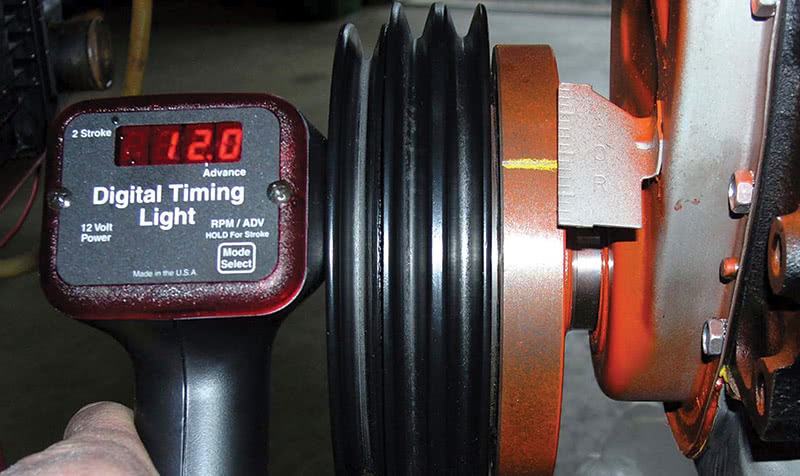
No distributor test stand? You can still get good results with a dial-back timing light. You can even use a plain timing light if the engine has a degree band on its harmonic balancer.
Checking the basics
We always check the basics first by making sure the spark plugs and plug wires are in good shape, then we run the engine and look for excessive blow-by. We then use an ignition scope to check the spark output, and perform a cylinder balance test so we can be sure each cylinder is doing its share. If all that’s okay, the next step is to check the existing spark advance curve(s).
The best way to check both the vacuum and mechanical advance curves is with a distributor test stand, but this may be considered an obsolete piece of equipment in a modern service shop, so you may not have one anymore.
Note: Rpm or advance readings given by a distributor test stand are doubled because the distributor turns at half of the engine speed, thus a reading of 12 degrees advance at 1,750 distributor rpm equals 24 degrees at 3,500 engine rpm.
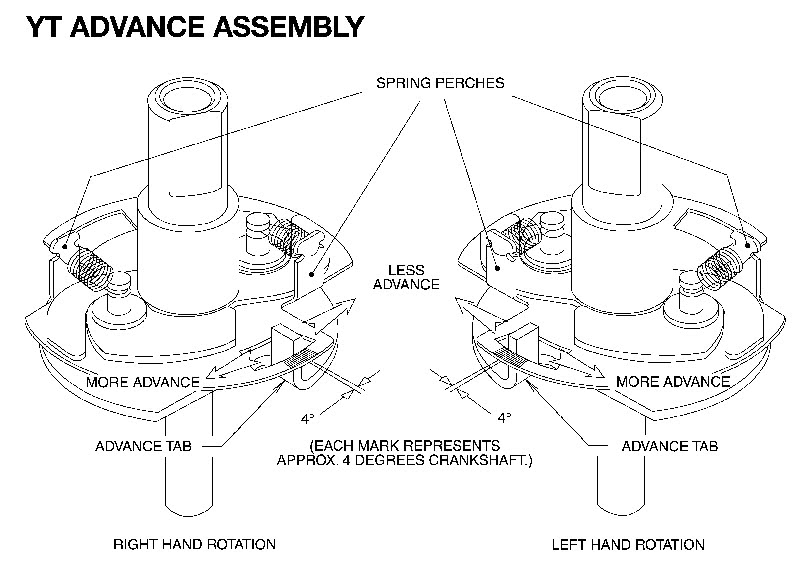
On this high-performance distributor, the total mechanical advatnce can be limited by bending the tab. Don’t go beyond 32 deg., or below 16
(courtesy Mallory).
If you don’t have access to a distributor test stand, you can check the vacuum and mechanical advance curves by using a manual vacuum pump and an advance-reading/dial-back timing light (if the engine has a degreed harmonic balancer, you can read the amount advance with a standard timing light). First, observe the amount of spark lead from the mechanical advance in 2
50-rpm steps from idle until it quits advancing. A distributor test stand works much better because you can run the distributor at 6,000 engine rpm or more without the fear of blowing anything up. In many cases, a distributor may still be advancing the timing well above 6,000 engine rpm, therefore the advance curve can be checked across the entire rpm range where the engine will be used.
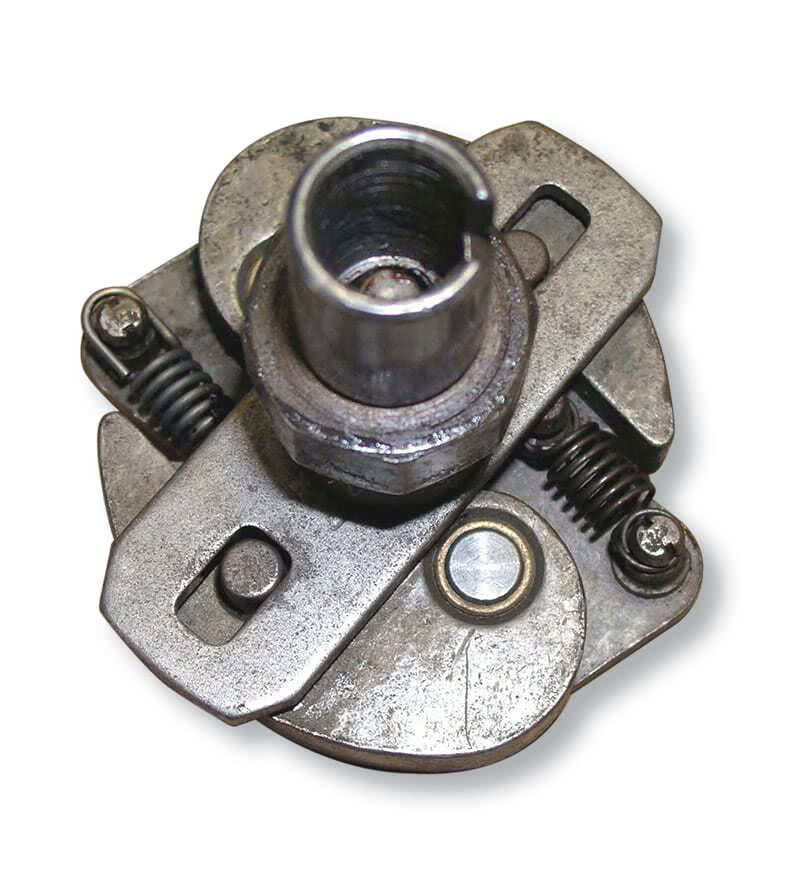
The Mopar O.E.M. centrifugal advance mechanism isn’t very tuner-friendly.
To check the vacuum advance curve, use the manual pump to vary the vacuum supplied to the vacuum advance while using the timing light to read the amount of advance provided. Go all the way from one to 23 in. Hg.
Mechanical advance
The mechanical spark advance has three components: the initial advance, the rpm-based advance rate provided by the weights and springs, and the upper advance limit. The advance rate of most OEM and performance replacement distributors can be modified by the use of different springs, but changing the total amount of mechanical advance is not always that easy. The method the distributor manufacturer uses to limit the mechanical advance varies from brand to brand. Some are easy to tune, while others can be a challenge. Before you buy any replacement distributor, be sure it allows you to easily adjust both the rate and the total amount of mechanical advance!
One of the best guides we’ve found for determining what initial timing is best for an engine is in the Barry Grant catalog and/or web site in the Demon carburetor selection guide. They recommend 10 to 12 deg. of initial timing when the camshaft duration is less than 220 deg. at 0.050 lift, 14 to 16 degrees of initial timing with less than 240 deg. at 0.050, and 18 to 20 degrees of initial timing with a cam with less than 260 at 0.050. We use 12 degrees for most vintage cars and muscle cars with mild cams since the camshafts they use are typically well under the 220 degree at 0.050 guideline.
The rpm spark advance rate we use most causes all the advance to be in by 3,200 to 3,600 rpm. This rpm range is a good starting point. You can gain power if you allow the advance to come in sooner, but only at the risk of engine damage from detonation if you overdo it.

On this type from the same manufacturer, you loosen the locking screw and set the limit using gauge keys (courtesy Mallory).
The advance curve, as determined by the advance springs, should not start advancing the spark until the engine rpm is raised above the base idle speed, and must not advance so quickly that the engine experiences detonation/ping problems.
A 9.5:1 compression small block Chevrolet, Ford or Chrysler will in most cases respond well to 36 deg. of total ignition advance (initial timing plus the mechanical timing). Whenever you increase the initial timing the total mechanical ignition advance must be checked and possibly reduced. If the total ignition spark advance needs of the engine are exceeded there will be a major risk of damage from the resulting detonation. Whenever you increase the initial advance, you must decrease the mechanical advance system so the engine has the same total advance!
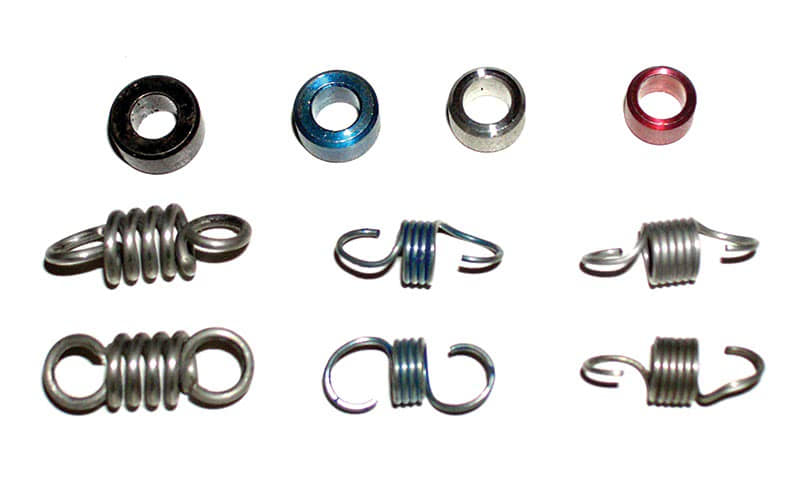
The spring and bushing kits for modifying mechanical/centrifugal advance mechanisms are simple. Not so the expertise. MSD distributors have a GM-style centrifugal advance mechanism. Note the heavy springs.
Many of our customers have installed air-gap or other race-designed intake manifolds on their street-driven muscle cars. These and many of the aftermarket high performance cylinder heads available eliminate the exhaust crossover (heat riser) through the intake manifold. This lack of heat in the intake manifold can cause significant hesitation and low rpm drivability problems — the gasoline won’t stay vaporized in cool weather and condenses on the manifold surface, thus leaning out the mix. One of the tricks we use to address these drivability issues is to tune in an ignition advance curve that allows the initial timing to be in the 18-20 deg. range. Another possibility is the installation of a race-designed carburetor, such as a Mighty Demon from Barry Grant.
MPG and the vacuum advance
The spark advance needs of an engine change along with changes in both load and the air/fuel mixture. The leaner mixtures the engine gets from the carburetor at light throttle cruising speeds takes longer to burn than the richer air/fuel power mixture provided at wide-open throttle or heavy acceleration/high loads. This means that these leaner mixtures need the ignition spark earlier in the compression stroke to allow more burn time so that peak cylinder pressure is reached at the correct moment for maximum fuel efficiency. A vacuum-based spark advance system allows advance when the intake manifold vacuum is high, which provides this extra time.
When we’re using a “hot rod†mechanical advance curve, we tend to limit the amount of additional advance from the vacuum system to about 10 to 12 deg. Most OEM vacuum advance units we see have 16 to 24 deg. of advance, which in our experience is excessive for today’s gasoline. Vacuum advance should not be in before 10 in. Hg to avoid detonation/ping problems on light to moderate acceleration. Most adjustable vacuum advance units only allow you to change the rate of advance, and have no means of limiting the total amount. If you can’t find a unit that matches your needs, you may have to build a stop to limit the advance travel.
The vacuum advance needed once the mechanical advance has been optimized for the engine and fuel combination is lower than that used in the days of leaded gasoline. The 54-deg. total advance limit (initial + mechanical + vacuum) most tuners used for a typical V8 engine back in ancient times is way too much for the burn characteristics of reformulated gasoline. When the total timing exceeds 48 to 50 degrees, the misfire rate (seen on a five-gas analyzer as HC) tends to increase with the reformulated gasoline here in northern California, but this may differ with the blend of gasoline you have in your part of the country.
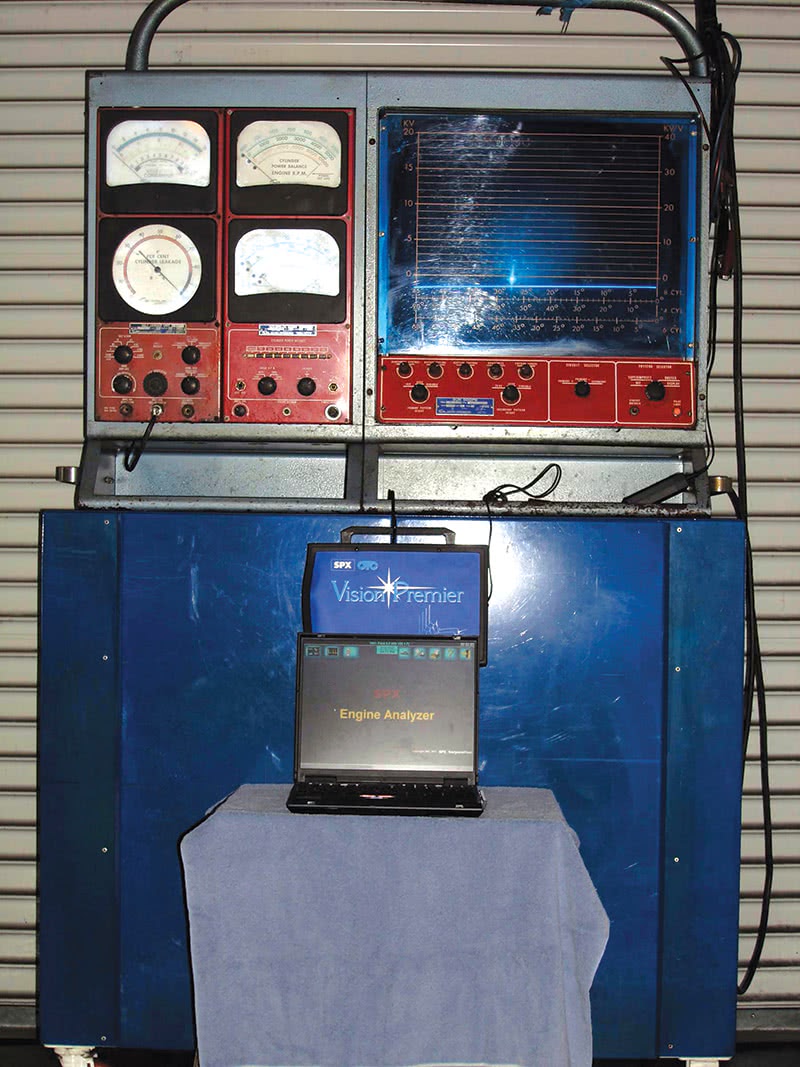
While an old-fashioned secondary ignition scope can still be useful in work on vintage vehicles, in no way does it match the capabilities of the laptop programs/systems available.
Ignition tuning with an exhaust gas analyzer
The readings from a five-gas exhaust analyzer can allow the tuner to look for NOx (Nitrogen Oxide). The level of NOx in the exhaust will rise as the engine gets close to detonation, such as may happen when the mechanical (rpm based) timing is advancing too quickly, or providing too much spark advance for the octane number of the gasoline when the engine is under load. An exhaust analyzer can also give you the means to tailor the advance systems to the needs of the engine by looking for excess HC and high O2 as an indicator of misfire, and high NOx readings as an indicator of high temperatures early in the combustion process. The correct spark timing will also cause the engine’s vacuum to be at its highest under every load condition. We will discuss how we use a five-gas exhaust gas analyzer for tuning in more depth in Part 2 of this article.
The proper tuning of the initial timing and the ignition spark advance curve(s) is a very important first step in restoring the power and drivability that was built into the engine of your customer’s carbureted vintage or muscle car so it will run its best with the reformulated gasoline of today!
Â


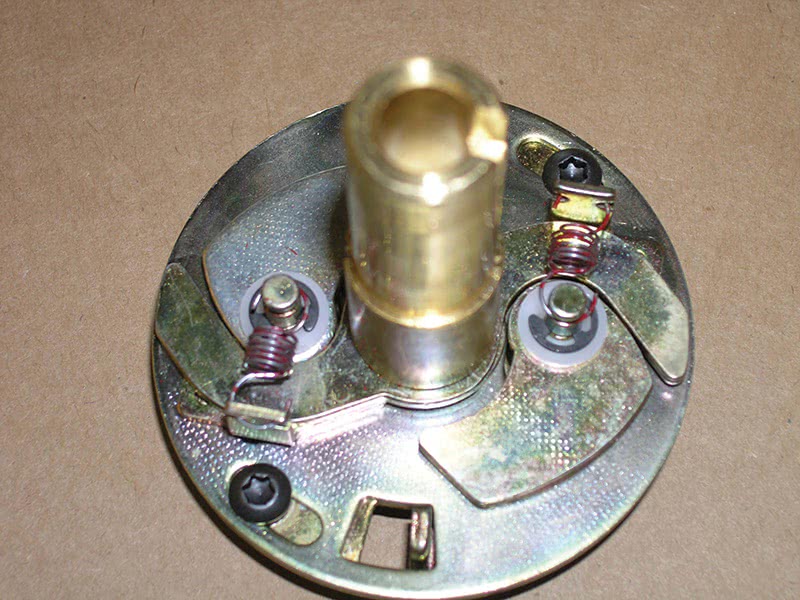
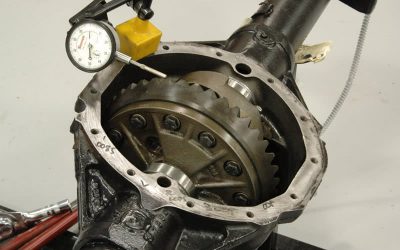
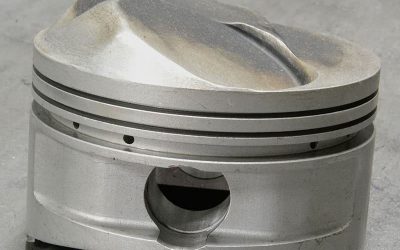
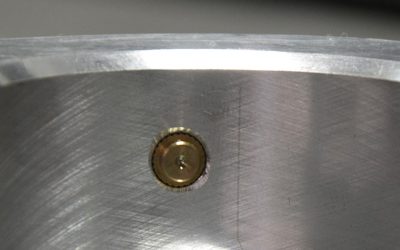
0 Comments